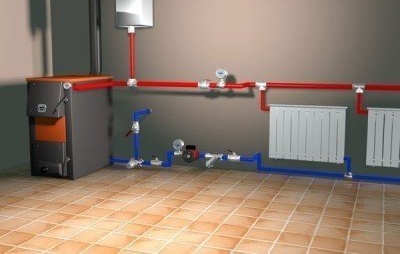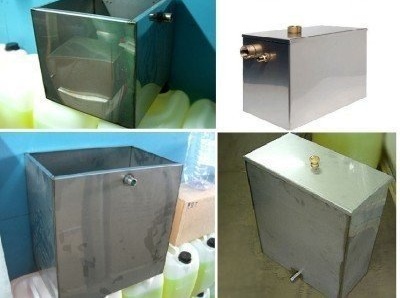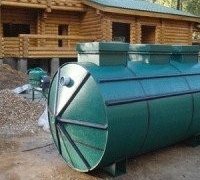Open heating system: the principle of operation of such a scheme + an overview of strengths / weaknesses
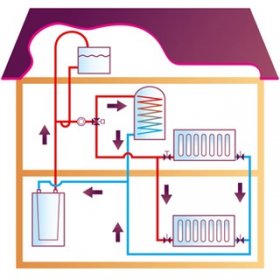
Due to the ease of installation and maintenance, as well as the low price, an open heating system is still popular. Over the years, it has undergone some changes and has already been successfully used in villages, villages, cottage villages, which are provided with gas supply, in an updated form. It is an excellent option for heating a small area, for example, a one-story summer house. Low-cost maintenance plus sufficient efficiency - according to these criteria, many summer residents choose this scheme.
The principle of operation of an open system
For full operation, an open heating system does not need additional use of the pump. The coolant circulates through the pipes due to the difference in density - we are talking about cold and hot water.
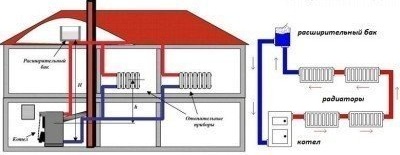
The diagram clearly shows the main parts of an open heating system: boiler, expansion tank, radiators and pipes
The design of the system is elementary and consists of several main parts:
- solid fuel, gas, diesel heating boiler - choose the best option;
- cast iron or steel radiators;
- steel expansion tank;
- pipes.
The principle of action is based on the well-known laws of physics. Water is heated in the boiler and rushes through pipes to a zone of lower pressure under the action of high pressure. After going through all the radiators and cooling down, she returns to the boiler. It is no secret that when heated, the substances expand, this also happens with water. For this reason, the required part of an open system is expansion tank, which compensates for the excess coolant. It should not be airtight. A pump is not required, but there are options for using it. A mortise tap is required to remove air.
Conventionally, the entire scheme can be divided into 2 parts. The first is “supply”: heating the coolant and moving it through pipes and radiators; the second is the "return": cooling and returning it to the boiler.
Features of the open circuit:
- the expansion tank must be above the rest of the system;
- the larger the diameter of the pipes, the better the circulation;
- water is a more desirable coolant than antifreeze;
- water evaporates, so you should monitor its level.
In order for such a heating system to function correctly, it is important to comply with the recommended pressure. To do this, a special node is installed, called a subspecies. You can read more about this in our next article:https://aquatech.tomathouse.com/en/otoplenie/kotelnaya/podpitka-sistemy-otopleniya.html.
Will self-assembly be tough?
In order to cope with the installation of an open heating system, you do not need to have special knowledge or extensive experience. First of all, a boiler is installed, which can be either mounted or floor-mounted. The type of boiler depends on the convenience of placement, and its power - on the area of the heated room.
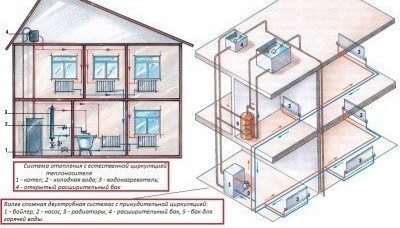
The power and dimensions of the components of the heating system depend on the total area of the house
Next, calculate and install radiators. They can be replaced with a very simple option - a pipe with a diameter of 8-10 cm, which runs along the perimeter of the entire house and returns to the boiler. A slight slope of the pipe will increase the circulation of the coolant. In an elementary scheme, the tank is installed on the return, next to the boiler, but always above the rest of the equipment.
Another option is a one-pipe vertical layout, requiring the installation of an expansion tank in the attic. Accordingly, the attic should first be insulated so that the tank does not freeze in the winter.
Important! Pay attention to the correct calculation of the size of the expansion tank. Insufficient volume can not withstand high pressure, as a result of the pipe simply breaks.
Also pay attention to the material on how to correctly calculate the number of sections of heating radiators:https://aquatech.tomathouse.com/en/otoplenie/raschety/raschet-kolichestva-sektsiy-radiatorov-otopleniya.html
Component selection
- Boiler. The ideal place to install the boiler is a separate room, spacious enough (for ease of maintenance) and with access to fresh air. The flooring must be made of fireproof material, such as concrete. By calculating the area of the house, you can determine the required boiler power. It can work on coal, gas, wood, diesel fuel.
- Radiators Types of radiators: steel, bimetallic, cast iron, aluminum. The most popular are steel. They should be mounted at a distance of 3-5 cm from the wall, not less. The traditional installation location is under the window, so that they serve as a barrier to cold air from the street. The most convenient height is 40-60 cm so that there are gaps: from above to the window, from below to the floor. The length can be any, depending on the area of the room. For example, for a bedroom of 15 m², a radiator 100 cm long is enough.
- Pipes. Copper pipes are relatively expensive, steel has been rusted since time, so almost everyone chooses plastic. Diameter - 25 mm, 32 mm. The number of pipes depends on the type of system - single pipe or double pipe. As a rule, they are not built into the wall, but carried out in an open way - directly above the floor. Pipes are cut into sections convenient for installation and connected to the boiler, expansion tank and radiators using taps.
- Expansion tank. Its location is in the attic or near the boiler. It should be remembered how the volume of the tank relates to the dimensions of the system as a whole: it should not be less than 5% of the volume of the entire system. For a one-story private house, a tank of at least 8 liters is needed, but it is better to purchase with a margin of 15 liters.
You can read about the choice of pipes for installing a heating system, their types and characteristics in our next article:https://aquatech.tomathouse.com/en/uchebnik/truby/kakie-truby-dlya-otopleniya-luchshe-vybrat.html.
Advantages and disadvantages of the system
To begin, consider the positive aspects - it is not for nothing that this system is still actively used.
- The simplicity of the circuit. It has long been known: the simpler the device, the more reliable it operates and the faster you can cope with a breakdown.
- The functioning of the equipment, despite the lack of electricity. The heat in the house depends only on the presence of gas.
- Easy to install. Prepared parts can be assembled in one day.
- Fast entry into working mode, no less quick stop. The beginning and end of the system depends on the on / off of the boiler.
- Low cost of components.
Of course, the open heating system circuit has its drawbacks. There will always be a user who does not like certain properties of equipment or operation.
For example, many are not satisfied with the large sizes of parts and the entire system as a whole.If the structure is not very large, it can be difficult to arrange the equipment so that it does not interfere with comfortable living.
In some cases, an open expansion tank adversely affects radiators and pipes: they are susceptible to corrosion.
Important! Particular attention should be paid to the evaporation of the liquid in the tank. Air entering the pipes causes them to overheat. One way to solve this problem is a layer of oil on water with a thickness of 1-2 cm.
Adherents of the closed system argue that the open type is less effective, its efficiency is much lower.
